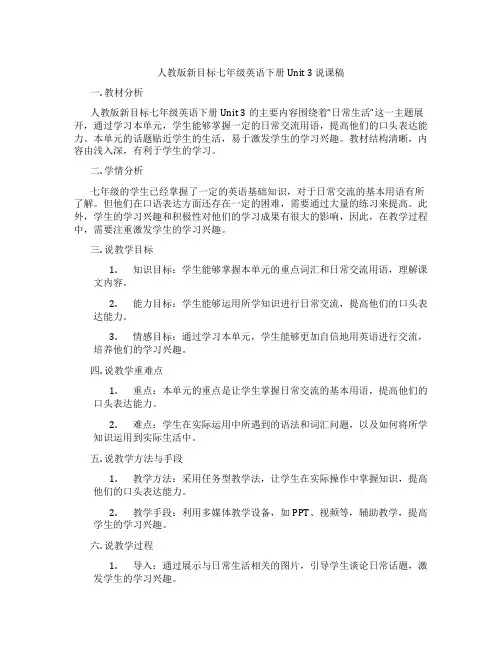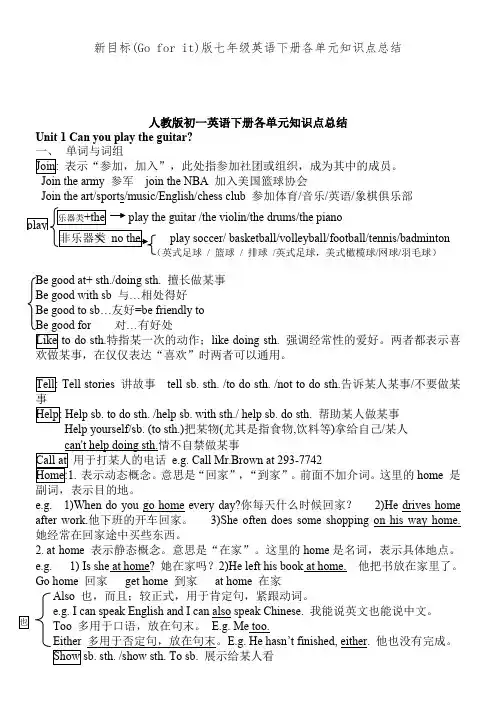新目标(go for it)英语七年级下学期UNIT3 Why do you like koalas
人教版新目标_go_for_it!七年级下册_英语__1-12单元知识点

七下1—6单元必背句子与词组Unit1 Where’s your pen pal from? (ok)1. --你的笔友来自哪里? --your pen(无―实义动词come, 用is/are‖) --他来自加拿大。
-- Whereyour pen pal(有―实义动词come, 用do/does‖)练:They’re _______ Australia, a beautiful country.A. come fromB. comes fromC. fromD. for2. --你的笔友来自加拿大吗?(用法同上) --是的。
your pen Canada? (用法同上)--3. 他来自澳大利亚:He is fromAustralia. 他是澳大利亚人:He is4. --你的笔友住在哪里?--他住在多伦多。
-- He/She lives in Toronto.练:-- When _____ the girl _____ her homework? -- In the evening.A. does, doesB. does, doC. is, doD. is, does-- _______ your sister have a pen pal? Yes, she _______.A. Is, isB. Does, doC. Can, canD. Does, does-- Ling Tao is a Chinese, but now he _______ in the UK.A. liveB. isC. is fromD. comes from5. --你的笔友说什么语言?--他说英语。
-- He/She speaks English.speak+语言;语言;语言;tell sb练:My new pen pal ________ me that he can ________ Chinese but only a little.12I can’t ________ French, but I can ________ it in English.6. 我喜欢和我的朋友一起去看电影:I liketo the moviesmy friends.①②③7.write e-mailsto each other8. 9. 告诉我关于你自己: 讲故事给某人听:10.11.相似单词比较:(1) 信:letter 一点:little (2) 法国:France 法语:French12. (1) like v. 喜欢; 如:(2) like prep. 像; 如:13. (1) country n. 国家; (2) country n.14. (1) from perp. 来自; 如:(2) from prep. 从; 如:Unit2 Where’s the post office? (ok)1. 问路:(1) Excuse me, how can I get to the post office?(2) Excuse me, can you tell me the way to the post office?2. --这儿附近有一个邮局吗?--是的。
人教版新目标七年级英语下册Unit3说课稿

人教版新目标七年级英语下册 Unit 3 说课稿一. 教材分析人教版新目标七年级英语下册Unit 3的主要内容围绕着“日常生活”这一主题展开,通过学习本单元,学生能够掌握一定的日常交流用语,提高他们的口头表达能力。
本单元的话题贴近学生的生活,易于激发学生的学习兴趣。
教材结构清晰,内容由浅入深,有利于学生的学习。
二. 学情分析七年级的学生已经掌握了一定的英语基础知识,对于日常交流的基本用语有所了解。
但他们在口语表达方面还存在一定的困难,需要通过大量的练习来提高。
此外,学生的学习兴趣和积极性对他们的学习成果有很大的影响,因此,在教学过程中,需要注重激发学生的学习兴趣。
三. 说教学目标1.知识目标:学生能够掌握本单元的重点词汇和日常交流用语,理解课文内容。
2.能力目标:学生能够运用所学知识进行日常交流,提高他们的口头表达能力。
3.情感目标:通过学习本单元,学生能够更加自信地用英语进行交流,培养他们的学习兴趣。
四. 说教学重难点1.重点:本单元的重点是让学生掌握日常交流的基本用语,提高他们的口头表达能力。
2.难点:学生在实际运用中所遇到的语法和词汇问题,以及如何将所学知识运用到实际生活中。
五. 说教学方法与手段1.教学方法:采用任务型教学法,让学生在实际操作中掌握知识,提高他们的口头表达能力。
2.教学手段:利用多媒体教学设备,如PPT、视频等,辅助教学,提高学生的学习兴趣。
六. 说教学过程1.导入:通过展示与日常生活相关的图片,引导学生谈论日常话题,激发学生的学习兴趣。
2.新课呈现:讲解本节课的重点词汇和日常交流用语,让学生进行实际操作,如角色扮演等。
3.课堂练习:设计一些日常交流的场景,让学生进行实际运用,巩固所学知识。
4.课堂小结:对本节课的内容进行总结,让学生明确学习目标。
5.课后作业:布置一些与日常生活相关的任务,让学生课后进行练习,提高他们的口头表达能力。
七. 说板书设计板书设计要清晰、简洁,能够突出本节课的重点内容。
新目标七年级英语下册unit3why do you like koalas 讲解与练习

班级 姓名 考场 考号 座位号 号-------------------------○密--------------------------------------○封------------------------------------○线----------------------※※※※※※※※※※※※答※※※※※※※※※※※※※※※※※※题※※※※※※※※※※※※※※※※※线※※※※※※※※※※Unit 3 Why do you like koalas?讲解与练习讲解 一、词组1.like to do sth / like doing sth 喜欢做某事2.play with … 与...一起玩3.be quiet 安静4.during the day 在白天5.at night 在夜间6.eat grass 吃草7.eat leaves 吃树叶8.very shy/ smart/ cute 非常害羞/聪明/可爱9.South Africa 南非 10.other animals 其他动物 二、日常交际用语(1)-Let’s see the lions frist.咱们先看看狮子吧。
(Let’s do…first.咱们先做……。
其中Let’s 是let us 的缩写形式,意思是―让我们、咱们……‖,一般用来提出建议,后接动词原形。
其中first 是副词,意为―首先‖表示顺序,其位置可置于句尾,也可置于句首。
) Eg:-Let us play games. –Great! -Let me see.(2)-Do you like giraffes?你喜欢长颈鹿吗? Yes,I do.是的,我喜欢。
/ No,I don’t.不,我不喜欢。
(Do you like+n.?你喜欢……吗?其中名词可为不可数,也可为可数,当是可数名词时要用它的复数形式。
) (3)-Why do you want to see the lions?你为什么想去看狮子呢? -Because they are very cute.因为他们逗人喜爱。
人教新目标英语七年级下册Unit3Howdoyougettoschool?单元练习

人教新目标英语七年级下册Unit3Howdoyougettoschool?单元练习学校:___________姓名:___________班级:___________考号:___________一、完型填空David is 6 years old. 1 parents work in a big city(城市).They are very 2 and don't have time to look after(照顾)him.David 3 with his grandparents in a small village. David's parents work in a factory(工厂).They live 4 from the factory. It's about 31 kilometers from their home to the factory. So they have to get up 5 in the morning.They usually 6 home at 6:30. They walk to the bus station and 7 the No.10 bus to the subway station. Then they go to the factory by 8 . It takes them about two 9 to go to work. The trip to their factory is really tiring(累人的), 10 they like their jobs very much.1.A.My B.His C.Your2.A.busy B.funny C.afraid3.A.helps B.lives C.plays4.A.far B.well C.usually5.A.best B.early C.quickly6.A.get B.lose C.leave7.A.buy B.take C.drive8.A.bus B.train C.subway9.A.days B.hours C.minutes10.A.or B.but C.because二、补全短文5选5阅读短文,根据短文内容,从短文后的A、B、C、D、E五个选项中选出能填入空白处的最佳选项。
新目标(Go for it)版七年级英语下册各单元知识点总结

新目标(Go for it)版七年级英语下册各单元知识点总结人教版初一英语下册各单元知识点总结Unit 1 Can you play the guitar?一、 单词与词组表示“参加,加入”,此处指参加社团或组织,成为其中的成员。
Join the army 参军 join the NBA 加入美国篮球协会Join the art/sports/music/English/chess club 参加体育/音乐/英语/象棋俱乐部play soccer/ basketball/volleyball/football/tennis/badminton / 篮球 / 排球 /英式足球,美式橄榄球/网球/羽毛球)Be good at+ sth./doing sth. 擅长做某事Be good with sb 与…相处得好Be good to sb …友好=be friendly toBe good for 对…有好处特指某一次的动作;like doing sth. 强调经常性的爱好。
两者都表示喜讲故事 tell sb. sth. /to do sth. /not to do sth.告诉某人某事/不要做某帮助某人做某事Help yourself/sb. (to sth.)把某物(尤其是指食物,饮料等)拿给自己/某人e.g. Call Mr.Brown at 293-7742意思是“回家”,“到家”。
前面不加介词。
这里的home 是e.g. 1)When do you go home every day?你每天什么时候回家? 2)He drives home after work.他下班的开车回家。
3)She often does some shopping on his way home. 她经常在回家途中买些东西。
2. at home 表示静态概念。
意思是“在家”。
这里的home 是名词,表示具体地点。
[人教新目标版]七年级英语下册Unit3Howdoyougettoschool词汇篇试题含答案
![[人教新目标版]七年级英语下册Unit3Howdoyougettoschool词汇篇试题含答案](https://uimg.taocdn.com/cb4fc4e02cc58bd63186bd49.webp)
Unit3词汇篇____________________________________________________________________________________________________________________________________________________________________学生通过本讲学习,能够掌握本单元的重点词汇句型,并在综合能力上有一定的拓展。
1.take a bus/by bus/on a bustake a bus做谓语成分,表示坐公交by bus/on a bus做状语成分,by bus为抽象的交通方式,介词用by,名词前没有任何冠词,on a bus表示一种具体的交通方式,介词根据需要变化,名词前可有冠词或形容词,如in her car.2.get to/arrive at/arrive in/reach这四个词组都表示到达,arrive at+小地点,如arrive at school;arrive in+大地点,如arrive in China.3.take/spendtake当表示花费时间时,句型应为it takes/took sb.some time to do sthspend当表示花费时间时,句型应为spend some time on sth/spend some time(in)doing4.cross/across cross为动词,表示横穿,across为介词,需要和相应的动词连用,如run across the street.e true:实现,成为现实6.speak/tell/talk/say(1)speak表示说话的能力或说某种语言,(2)tell表示告诉某人某事tell sb.about或tell stories,tell lies,tell同时可以表示判断,辨别;(3)say表示说话内容;(4)talk表示交谈,如talk with sb或have a talk with sb.1.It only him20minutes to his office every day.A.takes;to driveB.took;driveC.takes;driveD.took;to drive解析:it形式主语,应用句型it takes/took sb some time to do sth的句型,又因为是一般现在时,故选C2.我每天乘公共汽车去上班。
人教版新目标go for it 七年级下册Unit3 单词拼写,课文填空和知识点总结梳理 含答案
人教版新目标七年级下册Unit 3 How do you get to school?单词拼写Unit 31.My grandpa is n__________ years old this year, but he is still very strong.2. The v__________ are very friendly. I like them.3. It t_________ me an hour to walk to school yesterday.4. There is an old b__________ over the river and every day a lot of people walk on it.5. The Yangtze River is about 6,397 k__________ long and it is longest river in China.6. It is dangerous for little children to c__________ the street alone.7. I am a__________ Mi ke can’t come here because he’s in Shanghai today.8. How about r__________ a bike to school?9. You can’t swim in this river because it runs very q__________.10. If you work hard, your dream can come t__________.【答案】1.ninety 2.visitors 3.takes 4.bridge 5.kilometers 6.clean 7.afraid 8.riding 9.quickly 10.true七下Unit3课文填空How do you to school? Do you walk or a bike? Do you go by bus or by train? For many students, it is easy get to school. But the students in one small village in China ,it is difficult. There is a very big river their school and the village. There is no bridge and the river (run)too quickly for boats. So thesestudents go on a ropeway to cross the river to school.One 11-year-old boy, Liangliang, (cross)the river every school day. he is notafraid.“I love to play my classmates. And I love my teacher. He’s like a father tome.”Many of the students and villagers never leave the village. It is their dream to have a bridge. Can their dream come ?Keys: get; ride; to; for; between; runs; crosses; But; with; trueSection A重点单词听,并跟读下列单词1. train n.火车2.bus n.公共汽车3. subway n.地铁4. ride v.骑n.旅程5. bike n.自行车6. sixty num.六十7. seventy num.七十8. eighty num.八十9. ninety num.九十10. hundred num. 一百11. minute n.分钟12. far adv.&adj. 远;远的13, kilometer= kilometre n.千米;公里14. new adj.新的;刚出现的15. every adj.每一;每个16. by prep.(表示方式)乘(交通工具) 17, drive v.开车18. car n.小汽车;轿车19. live v.居住;生活听,并跟读下列单词变形1.bus- buses(复数)2. sixty--sixties(复数)3. far-near(反义词)4.live- -living(现在分词)5. drive- driving(现在分词)- driver(名词)重点短语听,并跟读下列短语1.take the train乘火车2. take the bus乘公共汽车3. take the subway乘地铁4. ride a bike/ by bike骑自行车5. every day每天6. get to school到达学校7. one hundred and five一百零五8. how far多远9. how long多长时间10. ride a bike to school骑自行车去上学11. have a good day度过愉快的一天重点句型听,并跟读下列句子1.“你如何去学校?”“我骑自行车去学校。
人教版新目标七年级下Unit3_How_do_you_go_to_school_Section_B_2
1.先根据自己的实际情况回答五个提示问题。 2.将五个答语连成一段连贯的文字。 3.适当发挥自己的想象,写出其他可能的句子。 4.按e-mail的写作格式,先向对方进行问候,或客 套。然后,将以上文字整理成一篇小信件。 5.最后,再通读一遍自己的作品,看有没有错误 或不通顺的地方。就大功告成了!
1. Whendoyouleavehome? Ileavehomeathalfpastseven. _______________________________ 2. Howdoyougettoschool? FirstIwalktothesubwaystation.Then,I _______________________________ gettoschoolbysubway. _______________________________
Itusuallytakesmeabouthalfanhourtogetto ____________________________________ school.Iusuallymeetsmanyfriends.Somyt ____________________________________ ripisinteresting,too. ____________________________________ Peter
Onepossibleversion DearTom, Howareyou?Thankyouforyourlaste____________________________________ mail.Iknowhowyougettoschool.Nowletmet ____________________________________ ellyouhowIgettoschool.Iusuallyleavehome ____________________________________ athalfpastseven.First,Iwalktothesubwayst ____________________________________ ation.ThenItakethesubwaytoschool.Mysc ____________________________________ hoolisabouttenkilometersfrommyhome. ____________________________________ ____________________________________
新目标英语七年级下册Unit3Howdoyougettoschool?SectionB含答案
人教新目标版七年级下册Unit 3 How do you get to school Section B同步练习一、根据句意及汉语或首字母提示完成单词。
1、根据句意及汉语或首字母提示完成单词。
(1)There is a small v________ in the mountains.(2)The little boy isn't a________ of the snake.(3)There is a big river b________ the school and the village.(4)The students in places where there are rivers and lakes go to school by b________.(5)Hold on to(坚持) your ________(梦想). One day they may come true.二、用括号内所给单词的适当形式填空。
2、There are no ________ (bridge) over the river.3、He ________ (cross) the river to school every day.4、Many students and ________ (village) never leave the village.5、It's their dream ________ (have) a bridge.6、He is ninety ________ (year) old.三、英汉互译。
7、英汉互译。
①乘地铁________②多远________③到达学校________④从我家到学校________⑤drive to work ________⑥滑铁索________⑦an 11-year-old boy ________⑧between……and……________⑨实现________⑩cross the river ________四、单项选择。
人教版新目标英语(Go For It)七年级下册单词完整版笔记
hallway ['hɔːlweɪ] n.走廊;过道
hall [hɔːl]n.大厅;礼堂
dining hall餐厅
listen ['lɪs(ə)n]v.听;倾听
listen to…听…… 【listen to music 听音乐】
fight [faɪt]v. & n.打架;战斗
【fight with sb. 和某人打架 fight the fire 救火】
【an important test 一次重要的考试】 bring [brɪŋ]v.带来;取来 【反义词:take v.带走】 uniform ['juːnɪfɔːm]n.校服;制服 quiet ['kwaɪət]adj.安静的【be quiet 保持安静】 out [aʊt]adv.外出 go out 外出(娱乐) practice ['præktɪs]v. & n.练习【practice doing sth. 练习做某事】 dish [dɪʃ]n.碟;盘 do the dishes清洗餐具
小叶学英语
boat [bəʊt] n.小船 ropeway ['rəʊpweɪ] n.索道 year [jɪə] [ jɜː] n.年;岁 afraid [ə'freɪd] adj.害怕;惧怕【be afraid of sth. 害怕某物】 like [laɪk] prep.像; leave [liːv] v.离开 dream [driːm] n.梦想;睡梦 v.做梦 true [truː] adj.真的;符合事实的 【truth n.真相】 come true实现;成为现实 Dave[deiv] 戴夫(男名)
sorry ['sɒrɪ]adj.抱歉的;难过的;惋惜的
- 1、下载文档前请自行甄别文档内容的完整性,平台不提供额外的编辑、内容补充、找答案等附加服务。
- 2、"仅部分预览"的文档,不可在线预览部分如存在完整性等问题,可反馈申请退款(可完整预览的文档不适用该条件!)。
- 3、如文档侵犯您的权益,请联系客服反馈,我们会尽快为您处理(人工客服工作时间:9:00-18:30)。
interesting _______, _______,
friendly _______, _______
Section B-2b Listening
Maria thinks …while Tony thinks …
Animal Maria’s Words Tony’s Words
elephants interesting, (really) clever ugly
Because they are
cute.
Because they are beautiful. Because they are interesting.
Pair work
A: Let’s see the _____s first! B: Why do you want to see the ______s? A: Because they are ______.
Guessing game: What animal is it?
Guessing game: What animal is it?
elephant(s)
tiger(s)
dolphin (s)
lion(s)
penguin (s)
panda(s)
koala(s)
bear(s)
Where are koalas from?
They are from Australia.
Section A-3a
Where are ____s from? They are from _______.
• Section B-1,2a
d b 3. friendly__ 5. small __ 7. shy__c g 1. ugly___ h f 2. clever__ 4. beautiful e 6. cute___ 8. scary__ a __
duck
butterfly
dog
cocktail
horse
wolf
rabbit
swan
snake
monkey
cats
parrot
fun
lion
tiger
giraffe
elephant
penguin
panda
dolphin
koala
Describe animals
Panda:
cute shy _______, _______, lovely beautiful _______, _______,
Describe animals
Monkey:
clever intelligent _______, _______, smart lovely _______, _______,
cute _______, _______
Describe animals
Tiger:
scary cruel _______, _______, cool _______, _______,
Describe animals
Penguin:
funny _______, cute _______,
Section A-1a, 1b
b 1. tiger ___ h 2. elephant ___ 3. koalas ___ d 4. dolphin ___ a e 5. panda ___ 6. lion ___ f g 7. penguin ___ c 8. giraffe ___
Why do you want to see ___?
Section B-3a Listen and match
1. b
2. d
3. c
Section B-3a Read the descriptions and fill in the chart.
name Molly
Ling Ling
animal elephant
panda
age
12
where
Africa
Julia:
Julia: Julia:
koalas Let’s see the ______.
Because they’re _____ cute. very Why do you like dolphins _______?
Henry: Why do you like koalas _____?
dolphins Henry: Well, I like _______.
Africa years sleeps
eats
lazy
Retell the four passages.
name animal age where Africa China qualities like to play & eat grass beautiful, shy Molly elephant 12
qualities
likes to play & eat grass beautiful, la
cute, sleeps Australia during the day, eats at night
How to write about an animal Section B-3b
Unit 3
Why do you like koalas?
Section A
Do you know these animals?
tiger
Koala bear
elephant
lion
panda
giraffe
Dolphin
penguin
Guessing game: What animal is it?
Henry: Because they’re kind of interesting. ______
very dolphins kind of koalas
Step One Pair-work
A: Do you like …s?
B: Yes, I do. / No, I don’t.
A: Why?
cute smart fun interesting beautiful
interesting
cute
smart
beautiful
Listen and write the animals you hear. Draw a line from the animals to the description words.
pandas
beautiful, (kind of) cute (kind of) shy
Step One Reading
These three passages are put together. Please pick them out. •This is Molly. She is twelve years old and she is from Africa. She likes to play with her friends and eat grass. •This is Ling Ling. She’s five years old and she’s from China. She is very beautiful, but she’s very shy. So please be very quiet. •This is Bill. Isn’t he cute? He is from Australia. He sleeps during the day, but at night he gets up and eats leaves.
Animals Description Words
Step Three Listening
koalas 1.__________
dolphins 2.__________
a. interesting
b. cute c. fun d. smart
Step Three Listening
Listen again and complete the conversation.
Ling Ling Bill
Larry
panda
5
koala
lion 8
cute, sleep during the Australia day, eat at night eat meat, lazy, sleep, Africa relax
This is…
bear
deer
birds
eagle
B: Because they are very…
A: Let’s see …s (first).
B: Why do you like…?
A: Because they are…
Where are pandas from?
They are from China.
Where are lions from? They are from South Africa.
Guessing game: What animal is it?
giraffe(s)
tiger dolphin lion elephant
bear
giraffe
penguin
panda
koala
--Do you like _______s?
--Yes, I do. / No, I don’t.
